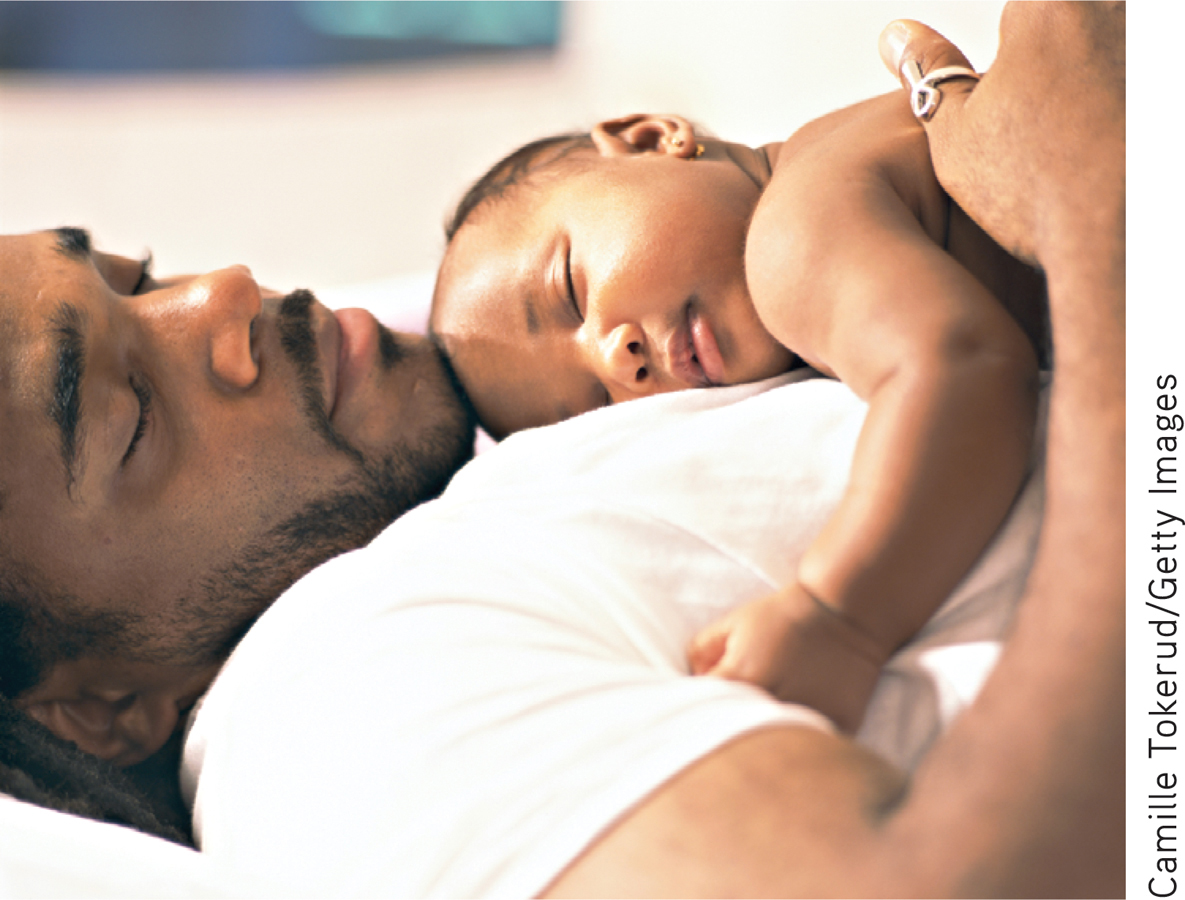4.2 Biological and Environmental “Clocks” That Regulate Consciousness

KEY THEME
Many body functions, including mental alertness, are regulated by circadian rhythms, which systematically vary over a 24-hour period.
KEY QUESTIONS
How do light, the suprachiasmatic nucleus, and melatonin regulate the sleep–
wake cycle? What is jet lag, and what causes it?
Throughout the course of each day, consciousness ebbs and flows in a natural rhythm. Along with our daily cycle of wakefulness and sleep, researchers have identified more than 100 processes that rhythmically peak and dip at consistent times each day. These variations in physiological or behavioral activities are called circadian rhythms. The word circadian combines the Latin words for “about” and “day.” So, the term circadian rhythm refers to a biological or psychological process that systematically varies over the course of each day. TABLE 4.1 lists examples of circadian rhythms.
circadian rhythm
(ser-KADE-ee-en) A cycle or rhythm that is roughly 24 hours long; the cyclical daily fluctuations in biological and psychological processes.
Examples of Human Circadian Rhythms
| Function | Typical Circadian Rhythm |
|---|---|
| Peak mental alertness and memory | Two daily peaks: around 9:00 a.m. and 9:00 p.m. |
| Lowest body temperature | About 97°F around 4:00 a.m. |
| Highest body temperature | About 99°F around 4:00 p.m. |
| Peak hearing, visual, taste, and smell sensitivity | Two daily peaks: around 3:00 a.m. and 6:00 p.m. |
| Lowest sensitivity to pain | Around 4:00 p.m. |
| Peak sensitivity to pain | Around 4:00 a.m. |
| Peak degree of sleepiness | Two daily peaks: around 3:00 a.m. and 3:00 p.m. |
| Peak melatonin hormone in blood | Between 1:00 a.m. and 3:00 a.m. |
| Sources: Information from Campbell (1997); Czeisler & Dijk (2001); Refinetti (2000); M. Young (2000). | |
The Suprachiasmatic Nucleus: THE BODY’S CLOCK
Your many circadian rhythms are controlled by a master biological clock—a tiny cluster of neurons in the hypothalamus in the brain. This cluster of neurons is called the suprachiasmatic nucleus, abbreviated SCN (see FIGURE 4.2). The SCN is the internal pacemaker that governs the timing of circadian rhythms, including the sleep–
suprachiasmatic nucleus (SCN)
(soup-ruh-kye-az-MAT-ick) A cluster of neurons in the hypothalamus in the brain that governs the timing of circadian rhythms.

Environmental cues are also involved in keeping the circadian rhythms synchronized. The most important of these cues is bright light, especially sunlight, but exposure to artificial light, including that generated by computer or tablet screens, also influences circadian rhythms (Dijk & others, 2012; Münch & others, 2012). In humans, light detected by special photoreceptors in the eye sends signals via the optic nerve to the SCN in the hypothalamus (Drouyer & others, 2007).
As the sun sets, the decrease in available light is detected by the SCN through its connections with the visual system. In turn, the SCN triggers an increase in the production of a hormone called melatonin. Melatonin is manufactured by the pineal gland, an endocrine gland located in the brain.
melatonin
(mel-uh-TONE-in) A hormone manufactured by the pineal gland that produces sleepiness.
Increased blood levels of melatonin help make you sleepy and reduce activity levels. Blood levels of melatonin rise at night, peaking between 1:00 and 3:00 a.m. Shortly before sunrise, the pineal gland all but stops producing melatonin, and you soon wake up. As the sun rises, exposure to sunlight and other bright light suppresses melatonin levels, and they remain very low throughout the day. In this way, sunlight regulates, or entrains, the SCN so that it keeps your circadian cycles synchronized and operating on a 24-hour schedule.
In the absence of external time cues, our internal body clock drifts to its natural—or intrinsic—rhythm. Interestingly, our intrinsic circadian rhythm is about 24.2 hours, or slightly longer than a day (Czeisler & Gooley, 2007). When there are no external time cues, our normally coordinated circadian rhythms become desynchronized (Dijk & Lockley, 2002).
Exposure to environmental time signals is necessary for us to stay precisely synchronized, or entrained, to a 24-hour day. When environmental signals are out of sync with your internal body clock, such as when you travel and cross multiple time zones, you may experience symptoms of jet lag. You experience physical and mental fatigue, confusion or problems concentrating, depression or irritability, and disrupted sleep (Eastman & others, 2005). For many people, it can take up to a week or longer to readjust to an extreme time change. People who work the night shift or swing shift can also experience jet lag symptoms.
Question 4.2
1kxY74yGOlPZzplNgwrjHrFrhvrGE81GWF62ZXgZ2AQm8Uupp5wluogMYE+7/iGS0kDWZPXe5WooScMjDwNdYqtDwh+Rf5mQ4doP4VKM/u7ZLaSgO/7Fu+3Wa86FaN/jKvdqqnLYm+5MUfOHn1XSIjFZ6/V+DLM8CYl7bkK7UHQ8029bPoSpQPERqqRmPQTF1mfRmbuER9IuiUUeqQ02CdniEKM2qBVgUlahy2D6+ETdzg23xdvDLY/nCrfrFf4WR0H3MFtqKMyUJIcHtMf09YAGvuz1hIJenXpOeYLnU06fdWf7MCoVtGM5wWmroWtf0y1SbTeN7Pup25AR2KoZEg==Test your understanding of Consciousness and Biological Clocks with
 .
.